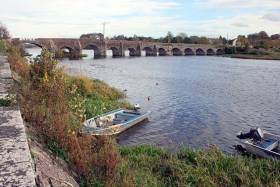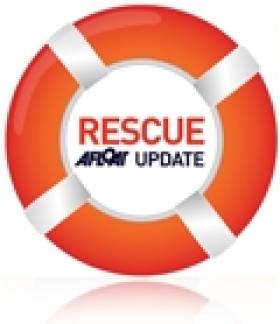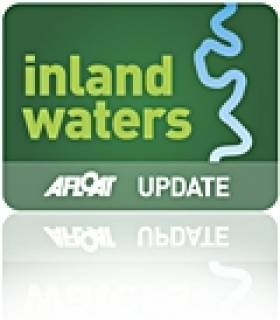Displaying items by tag: River Shannon
Limerick Man Convicted Of Illegal Fishing On River Shannon
#Angling - At a sitting of Killaloe District Court on Tuesday 5 April, Judge Patrick Durkan convicted a man of illegal fishing on the River Shannon at O’Brien’s Bridge in August 2015.
Joe Ahern of O’Brien’s Bridge, Co Limerick was found guilty of illegally fishing with prawns and was fined €750 and costs amounting to €1025. Ahern pleaded guilty to the offence and co-operated fully with the fishery officers.
Salmon angling on the River Shannon is currently permitted below O’Brien’s Bridge to Thomond Bridge in Limerick City under a local catch and release byelaw. Wild salmon must be returned immediately if caught and the use of prawns is prohibited under byelaw in the entire Shannon catchment.
These measures are present to protect returning wild salmon stocks, especially to large river catchments such as the River Shannon. The wild salmon populations in the Shannon River have declined in recent years.
In summarising his judgement on the case, Judge Patrick Durkan commented that fisheries were the greatest resource of this country and that fishery officers must be allowed to protect them.
Amanda Mooney, sirector at Inland Fisheries Ireland (IFI) in Limerick, said: “Anglers must adhere to conservation methods in place on our rivers as these measures are introduced to protect vulnerable stocks and provide an opportunity for rivers to recover.
"We need to work together to improve our stocks so that the wonderful resource can be passed onto the next generation. Inland Fisheries Ireland is committed to the protection of our wild salmon stocks.”
IFI has a confidential hotline number to enable members of the general public to report incidents - 1890 34 74 24 or 1890 FISH 24. This phone line is designed to encourage the reporting of incidents of illegal fishing, water pollution and invasive species.
Shannon Flood Risk Working Group Meets For First Time
#Flooding - OPW chair Clare McGrath yesterday (1 February 2016) chaired the first meeting of the Shannon Flood Risk State Agency Co-ordination Working Group established to enhance on-going co-operation across all of the agencies involved with the River Shannon.
Following the meeting, McGrath stated that “the group has discussed putting together a shared work programme for 2016 and is in the process of conducting an audit of roles and responsibilities.”
The Working Group will build on the existing work and commitment of all State agencies involved, namely the OPW; Waterways Ireland; Inland Fisheries Ireland; the ESB; Bord na Mona; Irish Water; the Environmental Protection Agency; the Department of Arts, Heritage and the Gaeltacht; and local authorities represented by the City and County Managers Association.
It is focussed on ensuring the best possible level of co-ordination between all statutory bodies involved in flood management on the Shannon, and to deliver the highest level of efficiencies to add value to the Catchment Flood Risk Assessment and Management (CFRAM) Programme.
McGrath added that the Working Group will meet again on 14 March to finalise its Shannon Flood Risk Work Programme 2016 and agree a process for wider consultation including with non-statutory bodies.
Working Group Terms of Reference
Informed by the National Catchment Flood Risk Assessment and Management Programme and in order to further effectively manage and mitigate the flood risk on the Shannon catchment, the Working Group will:
- Develop and agree a Shannon Flood Risk Work Programme (with identified output KPI’s) to focus and prioritise actions and activities to manage flood risk for the Shannon catchment.
- Provide coordinated direction and guidance to ensure delivery by State agencies, to meet their statutory role, of their constituent work programme in relation to flood risk management.
- Adopt and/or develop guidelines and protocols to inform and/or assist better co-ordination and co-operation by and between State agencies.
- Informed by an audit of roles and responsibilities in relation to flood risk management on the Shannon catchment, seek clarity on any legal and policy issues to inform its work.
- Consult with other bodies, including voluntary bodies and communities.
- Provide guidance in relation to roles and responsibilities for non-statutory bodies involved in managing flood risk on the Shannon catchment.
- When agreed, monitor and report quarterly on the implementation of the Shannon Catchment Flood Risk Assessment and Management (CFRAM) Plan.
- Develop other structures as an efficient approach to progressing and informing its work.
Pumps At The Ready In Portumna As Further Flooding Expected
#Flooding - Met Éireann confirms that further flooding is expected as prolonged falls of very heavy rain begin tonight (Friday 11 December) continuing through Saturday with totals of 30 to 50mm on lower ground.
Towns and villages along the Shannon have been warned to be braced for the worst flooding in that river's catchment for 20 years.
Galway Bay FM reports that four water pumps are already on standby in Portumna, where crews have managed to keep waters from rising over the bridge that connects the south-east Galway town to Tipperary.
Flooding is only the latest issue in the town, as a local councillor has complained about persistent dumping at Portumna Marina from illegally parked vehicles – though the waste has since been removed.
Pollution is also a problem in Clarinbridge, just outside Galway city, where locals fear the area's famous oysters, already downgraded from their 'A' status – allegedly due to runoff from a water treatment plant in Athenry – will be downgraded to the point of shutting down all harvesting. Galway Bay FM has more HERE.
Flood Relief Priority For Defence Forces As Shannon Breaks Banks
#Flooding - The Defence Forces have joined in flood relief efforts in Clare, Limerick and Westmeath as weekend rains risk significant flooding in the region.
As reported yesterday on Afloat.ie, the Shannon Catchment could see its worst flooding in two decades as spring tides exacerbate the effects of last weekend's Storm Desmond, which prompted a rare 'Status Red' warning for rainfall.
RTÉ News reports that the Shannon is already at dangerous levels, with a flood emergency response launched in Athlone after the waterway breached its banks in the Midlands town, threatening 100 homes.
Homes were also evacuated in Clonlara, Co Clare – between the Shannon and the Headache Canal – while the ESB was releasing water at its Inniscarra Dam facility in Cork to manage reservoir levels, warning of a subsequent risk downstream on the River Lee.
Meanwhile, Waterways Ireland has advised boaters to keep their vessels moored during this and other periods of stormy weather "and especially when national weather alerts are in place".
Even when the storms have passed, "users should be aware that the navigations will have changed significantly in nature and character" with the risk of strong currents, rising waters from flash flooding obscuring navigation markers, and falling trees weakened by storm-force winds.
Shannon Catchment Could See Worst Flooding In Years This Week
#Shannon - The worst flooding in two decades could fall upon the Shannon catchment in the coming days as spring tides accentuate the effects of last weekend's Storm Desmond.
According to The Irish Times, the Office of Public Works has told the National Emergency Co-ordination Committee that the River Shannon from Limerick to Athlone is the one area "giving most concern", with all gauging stations on the waterway showing only rising levels.
And spring tides this coming Friday and Saturday (11-12 December) are set to combine with "the fluvial flood wave coming down the Shannon" that is rated "in the severe category", warned the OPW's Jim Casey, who noted that the Erne catchment is also rising.
Meanwhile, the ESB has increased the flow of water from Parteen Weir at Ardnacrusha to help manage the Shannon's flood waters – but this too may lead to flooding of streets in Limerick city and suburbs.
The Irish Times has more on the story HERE.
'Deep Concern' Over Shannon Pipeline Proposal For Dublin Water Supply
#InlandWaters - A pipeline from the Shannon may be the solution for future water supply demands in Dublin and the Midlands.
But critics have expressed "deep concern" over its potential effects on boating tourism and biodiversity throughout the Shannon system.
Irish Water today (Thursday 26 November) announced that the Parteen Basin on the Shannon, close to the ESB's hydroelectric plant at Ardnacrusha, is its preferred option for the supply point of a 165km pipeline to serve a growing population in Midlands and East Coast counties, as RTÉ News reports.
Around 2% of water that would otherwise be used for power generation at the Ardnacrusha plant would be taken for distribution to a region that already comprises 40% of Ireland's population and is expanding rapidly, according to TheJournal.ie.
However, the Inland Waterways Association of Ireland (IWAI) claims that Irish Water's option does not account for the effects on water levels throughout the Shannon system.
"The preferred option of abstraction from Parteen Basin provides for all year round abstraction. This means that in good weather as water levels decrease on the Shannon it will also have to meet the increased water supply needs of Irish Water," said the IWAI in a statement.
"This will see further decreases in water levels all along the entire Shannon as the level is maintained in Parteen Basin to supply water and electricity."
Loss of boating traffic to the region and threats to already vulnerable waterways habitats are key concerns expressed by the IWAI, which has itself suggested desalinisation of coastal waters as an option for future needs.
The association also notes that Irish Water's neglecting to provide for surplus water storage "is a missed opportunity as it would allow for heavy abstraction during flood conditions and also provide a valuable resource to Midlands communities for new activities and enterprises."
A 10-week public consultation is now underway on Eastern and Midlands Region Water Supply Project, with more details available HERE.
Teens Rescued From Drifting Boat On River Shannon
#Rescue - Three teenagers were rescued by Limerick emergency services on Friday night (11 September) as their boat drifted out of the city along the River Shannon, as BreakingNews.ie reports.
The small fishing boat has experienced engine trouble and run out of fuel, leaving the three on board adrift till they were retrieved and their boat towed to safety.
It was the second callout to the river on Friday for the Limerick City Fire and Rescue Service, after a man fell into the river from Sarsfield Bridge in the early hours.
BreakingNews.ie has more on the story HERE.
Elderly Passer-By Saves Drowning Man's Life In Limerick
#Rescue - A life buoy thrown by an elderly passer-by helped save the life of a drowning man in the River Shannon at the weekend, as TheJournal.ie reports.
The incident occurred on Saturday afternoon (11 July) at the Shannon Bridge in Limerick city centre, where the elderly man spotted a man in his 40s enter the water near St Michael’s Rowing Club and threw him the life ring from the bridge walkway - keeping him afloat till emergency services arrived.
TheJournal.ie has more on the story HERE.
Teenager Dies In River Shannon Swimming Incident
#Shannon - A teenage boy has died after getting into difficulty while swimming in the River Shannon in Athlone yesterday (Wednesday 10 June), as RTÉ News reports.
The 14-year-old was recovered from the water near the Athlone Sub Aqua Club after a short search by club members and Coosan Point lifeboat volunteers.
But he later died in hospital after being transferred from Portincula to Temple Street.
RTÉ News has more on the story HERE.
River Shannon Documentary Scoops Top Award At 'Green Oscars'
#RiverShannon - A documentary on the natural history of the River Shannon has won the top award at the 'Green Oscars'.
Originally broadcast on RTÉ television as The Secret Life of the Shannon, the film On A River In Ireland also took the gongs for best cinematography and best script at the 2014 Wildscreen Film Festival in Bristol.
The awards organisers described the winning film as “a beautifully conceived film where the script, photography, music and editing create a magical hour, reconnecting us with nature in a way that very few films do today.”
On A River In Ireland follows Colin Stafford Johnson on a journey along the River Shannon, the longest river in the British Isles.
The film was shot over two years and features extraordinary animal behaviour captured with the very latest camera technologies.
And it has already enjoyed great success, winning three awards at the Jackson Hole Wildlife Festival, including best overall film.
Speaking after the win, director John Murray said: “My father grew up on the banks of the Shannon and to me as a child it was as wide and mysterious as the Amazon.
"In this film we tried to capture some of the wild animals and natural wonders that lie unseen under our very noses. It’s hugely gratifying that a film featuring Ireland’s wildlife would win against all comers from around the world, and a huge thanks to the team and everyone who helped us around the country.”
On A River In Ireland was made with the support of RTÉ, the BAI, ESB, the National Parks and Wildlife Service, Waterways Ireland and the Heritage Council, and produced with the support of investment incentives for the Irish film industry provided by the Government of Ireland.



























































